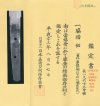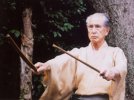AFAIK there's no bright line that separates katana from wakizashi. 25" isn't too weird for a katana, though, but it would be unusually long for a wakizashi.
SouthernComfort: Could you cite a reference for that? I've always read the 2 shaku line to be a really fuzzy one and only a generalization. If I'm wrong, I want to stop repeating it.
Chris,
Just saw your post, been away for the weekend.
No offense meant but, Yes, you should stop giving that information as it is just wrong. There are definite length criteria for determining tanto, wakizashi, katana. Historically, during some of the earlier periods there were some minute semi exceptions to this rule such as "Sunnobi Tanto" or Ko-Wakizashi. However, today authentication papers are only given in the three designations, even for the exceptions mentioned.
References are no problem, as this is well documented and considered novice knowledge.
pg. 48 "The Connoisseur's Book of Japanese Swords" by, Kokan Nagayama
pg. 2 "Glossary of Japanese Sword Terms" by, Dr. Gordon Robson Japanese Sword Society / US
Glossary "Nihonto Koza" by Dr. Junji Honma, Translated by Harry Watson
Pg. 46-47 "The Samurai Sword, A handbook" by John Yumoto
As well, I have included a photo of a set of papers issued from the "Nihonto Bijutsu Token Hozon Kai" or NBTHK.
This is the Sword preservation museum in Tokyo, whom are the most celebrated authorities on Japanese swords in the world.
I have highlighted in red the length of the sword clearly shown in Shaku, Sun, Bu.(see below)

ETA: More important than blade size is handle size. If it's made for one hand, then it's a wakizashi (or a really old tachi), but if it's made for two hands then it's a katana.
While, I don't really want to go into it, this is inaccurate as well.






